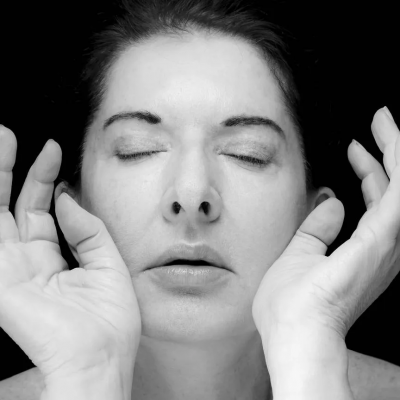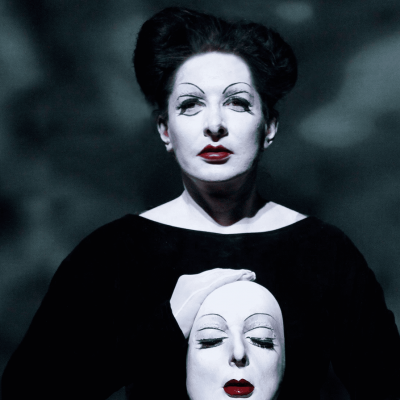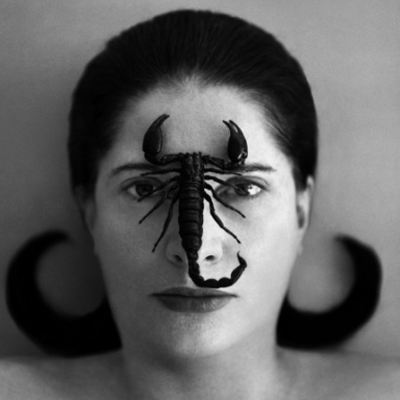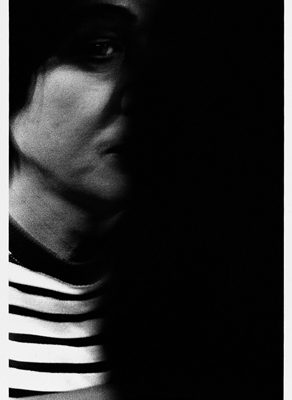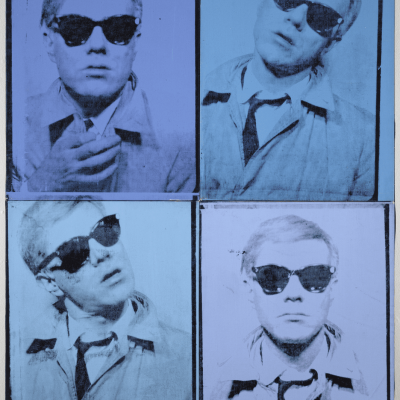
In the fall of 2023, London became the site of several major exhibitions or survey shows that brought to the fore the question of the identity, both artist and the artwork. The following commentary takes a series of Self-Portraits as a focus of attention. The self-portrait is of course persistent through art history, but in late modernity it becomes ever more diffuse and ubiquitous due mainly to the advent of social media. There are various figures that are attached to this focus, performance, repetition, suspension, otherness, sacrifice, desire, appearance, simulation, staging, drama, seriality, voice. In turn a grammar circulates within these, question marks, full stops, commas, footnotes, brackets, all indicating a fluctuation of such elements as minor or major, mediation and cipher, fragmentation, or limit. Is it assumed that the self-portrait stands in for the direct speech of a subject or is it on the contrary the impossibility of staging such an act? Can such an offering occur without the equal possibility of withdrawal happening as a sign of aesthetic ambivalence? So many questions, within in what is a likelihood of a whole sequence of suspended resolutions, which in part explains the persistence of the construct.
2023年秋季,倫敦成為多場重要展覽與回顧展的舞台,這些展覽將藝術家與藝術品的身份問題推向了前台。以下評論聚焦於一系列自畫像。
自畫像在藝術史中一直是一個持續的主題,但在晚期現代性中,隨著社交媒體的興起,它變得更加分散且無處不在。圍繞這一主題,多種概念交織其中:表演、重複、懸置、他者性、犧牲、慾望、外貌、模擬、舞台化、戲劇性、系列性與聲音。這些概念之間形成了一種獨特的語法:問號、句號、逗號、腳註、括號,暗示著元素在大小、調解、碎片化或邊界之間的動態波動。
自畫像是否被假設為一種主體直接話語的呈現?還是相反,它揭示了這樣一種行為的不可實現性?這種呈現是否可能不伴隨等量的退縮,而這退縮又成為了一種美學矛盾的標誌?在這其中,無數的問題浮現,形成一系列懸而未決的解答。而正是這種懸置,讓自畫像作為一種結構能夠持續存在,並保持其魅力。
Marina Abramovic @ Royal Academy
Until 1 January 2024
The exhibition at the Royal Academy of Marina Abramovic is really an exhibition divided into two halves, the first half with her collaboration with Ulay, and the second half as a solo act. Yet it does not quite appear as such, because already it is as if the faciality of Marina dominates in a way that might make one believe that she signifies memory and he, oblivion. Not that such a pairing of memory coupling with oblivion is intended to be the case but certainly it might have been destiny, if any such figure exists. Indeed, the overall sense of the show itself is of an enormous act of self-portraiture finally consuming all the various gestures and actions which constitute it. It is like an image of the self that can restore itself continually despite the threshold state it enacts as if it is the retelling of a story that always gets better each time it reiterates until a point is reached that the original impetus is lost. Everything is lent a second life whether with a mythic like framing, exaggeration, or documentary evidence rediscovering itself as art form. The most formative influence with this is of course that of Joseph Beuys but later the figure of Maria Callas becomes a dominant figure to emblemize an operatic dimension to the life of the artist. This might in turn be a case of another double appearing, a self that is capable of new guises at every turn, but one guided by enormous will to make manifest through the projection of identity within the staging of a drama. There is a rhetoric that accompanies this, high fashion mixed with mysticism, performance of the self, coupled with confessionals, attention to appearance and fiction, all in various configurations and circulations. It is gestural without ever being literary, increasingly grand in the tendency to evoke heavy matters such as thresholds, traumas, limits, abjections, and transgressions. At times there is the scent of a danger in the encounters, but always enough control to prevent limits being opened. This then is a source for vicarious pleasure that the work affords to the audience. In any overall assessment of the operation which has been performed what we are witnessed to is the transition of a body of work making a transition from the possession of an outsider and at times transgressive status into a mainstream authoritative practice that is self-aware of its historical position. The portraiture of the self thus travels from that of an outsider looking into that of an insider surveying the field of encounter from within. In effect this brings with it a sense of transition not only of the minor to the major but a sense of being able to be the source of authority within the emergence of a post-historical field of becoming in which the index for what was formally history, has become instead virtual. Close up, and personal, the work is transferred from being live to becoming an archive in which the self-portrait exists as a portal of the work’s afterlife.
倫敦皇家藝術研究院(Royal Academy of Arts)舉辦的瑪麗娜·阿布拉莫維奇(Marina Abramovic)展覽,可以說是一場分為兩部分的呈現:前半部分聚焦她與烏雷(Ulay)的合作,後半部分則專注於她的個人表演。然而,這種劃分並不明顯,因為瑪麗娜的「面孔性」(faciality)已然主導了整體氛圍。彷彿她象徵著記憶,而烏雷則象徵遺忘。這對記憶與遺忘的對偶並非刻意設計,但似乎昭示著某種命運的安排——如果我們承認命運的存在。
事實上,整場展覽給人的核心感受是一場龐大的自畫像行動,它最終吞噬了構成它的所有手勢與行動。這彷彿是一個自我形象的不斷重建,即使展現了一種臨界狀態,卻總能恢復自身。每一次重述都使故事更為完整,直到原初的衝動被消解。一切作品都被賦予了「第二次生命」,無論是通過神話化的框架、誇張的形式,還是被重新發現為藝術形式的紀實證據。
展覽的核心影響無疑來自約瑟夫·博伊斯(Joseph Beuys),但後來瑪麗亞·卡拉絲(Maria Callas)的形象成為主導,象徵了藝術家生命中歌劇性的維度。這或許又是一種雙重性的顯現:一個能在每一次轉折中重新塑造自身的主體,然而這一切都受制於一種巨大的意志,通過身份的投射與戲劇化的舞台呈現得以實現。
這其中蘊含著一種修辭——高級時尚與神秘主義的結合,自我表演與懺悔的交織,對外貌與虛構的專注——通過各種配置和循環得以展現。這是一種以動作為基礎的表現,而非文字敘述,其表現力愈加宏大,召喚著一些沉重的主題:臨界、創傷、邊界、卑賤與越界。某些時候,這些遭遇帶著危險的氣息,但始終保持足夠的控制,避免真正的邊界被打開。正是這種控制與釋放的張力,為觀眾帶來了替代性的快感。
在對這場展覽的整體評估中,我們見證了作品身份的轉變——從邊緣的、甚至是越界的姿態,進入主流權威性的實踐,並且對自身的歷史地位展現出清晰的自覺性。自畫像因此完成了一次從局外人凝視到局內人俯視的旅程,從外部的觀看者轉變為身處場域內的觀察者。
這種轉變不僅是從「次要」到「主要」的遷移,更帶來了一種新的權威感:在一個後歷史的生成場域中,成為權威的來源。在這樣的場域中,曾經是歷史的標誌,如今已成為虛擬的存在。作品從現場表演轉化為檔案,成為其後生命(afterlife)的入口,而自畫像正是通向這一入口的載體。
Sarah Lucas @ Tate Britain
Until 14 January 2024
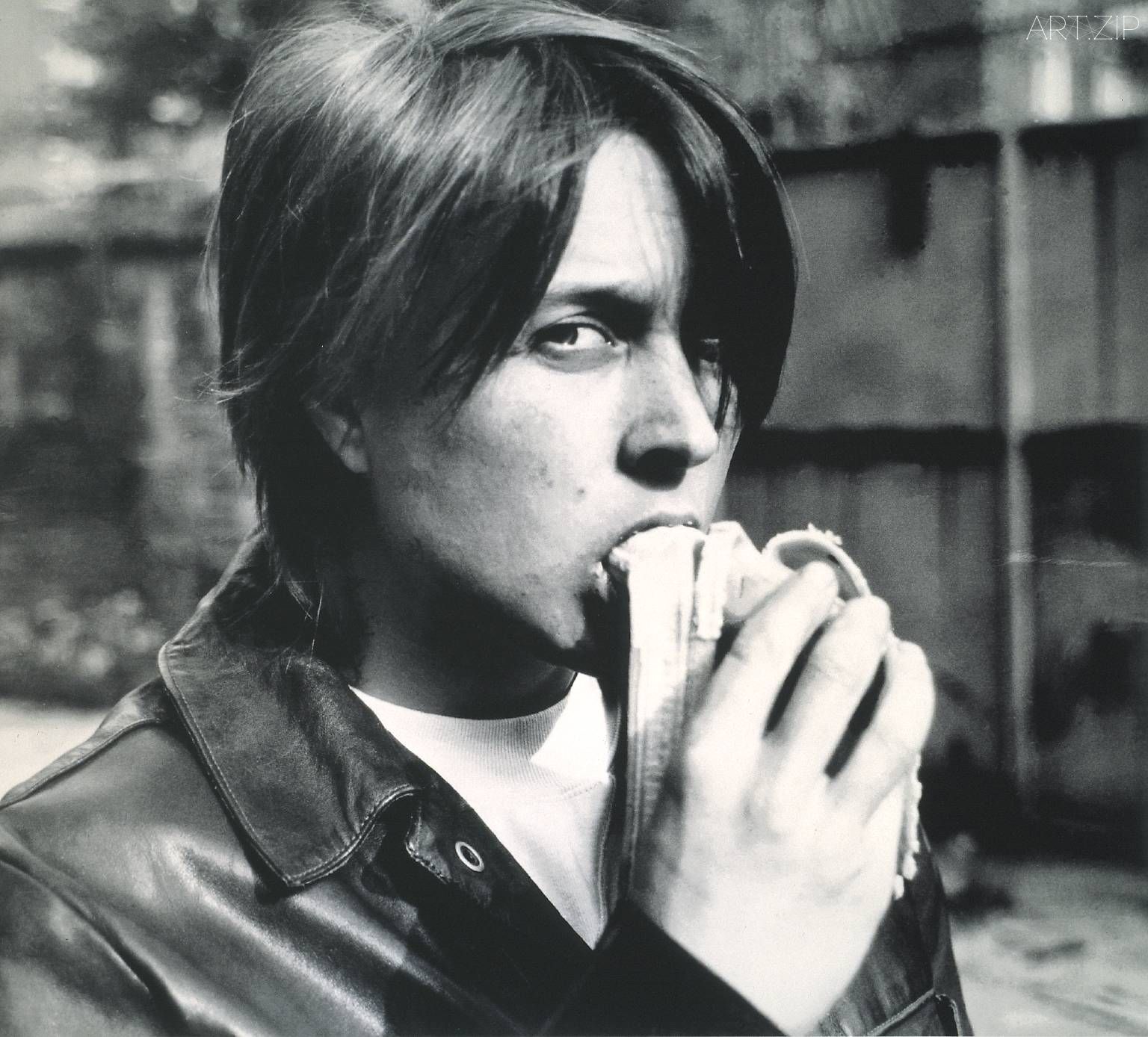
Eating a Banana 1990 Sarah Lucas © Sarah Lucas
Sarah Lucas’s presentation of the self through the medium of photography creates a narrative foundation for her overall construction and assembly of her work. There is within this an undercutting of high seriousness, even to the point of being tongue in the cheek. They utilize puns and play upon multiple readings that draw them close to the texture of everyday life. The props employed work on chains of association that open out humour. Eggs, bananas, melons, cucumbers, cigarettes, are all part of such stock like props that suggest the self as a site of performativity. A strange mixture of the comic mixing with references to transgressive theorisation, which has a tone that is drawn from an English sensibility of naughtiness, but in ways that overturn stereotypes, particularly those of gender. Modernist codes are invariably dispensed with in this process of subversion of lowly and sophisticated elements as ciphers of experience. The works in question are invariably at risk of lacking in mediation but that is invariably offered, if only in expletive form.
莎拉·盧卡斯(Sarah Lucas)通過攝影作為媒介來呈現自我,為其作品的構建與組裝奠定了敘事基礎。在這過程中,她消解了過於嚴肅的語調,甚至帶有幾分調侃與戲謔。她的作品運用雙關語和多重解讀,將其與日常生活的質地緊密相連。
雞蛋、香蕉、甜瓜、黃瓜和香菸等看似尋常的道具,被巧妙地編織成聯想的鏈條,開啟了幽默的空間。這些道具將自我定位為一個表演的場域,在奇特的喜劇性中融入對跨界理論的參照。這種幽默的基調源於英國式的俏皮感,但又通過顛覆性別刻板印象的方式實現了轉化,展現出一種對成規的挑戰。
在她對低俗與高雅元素作為經驗符號進行顛覆的過程中,現代主義的規範被徹底拋棄。這些作品雖然常常面臨缺乏中介的風險,但總能通過某種形式的介入來填補這一空缺,即便這種介入帶有粗俗語氣,也依然有效。
Daido Moriyama @ Photographers Gallery
Until 11 Feb 2024
Daido Moriyama is a photographer who eliminates distance from his work. There is a continuous trace that reflect his presence with the objects of his attention. He takes photographs quickly in ways that often transgress proper focus or composition, not for the sake of experiment with form but simply to convey the immediacy of his encounter with the subject. What then occurs when he becomes the subject? A meeting within the realm of shadows, a reflection in mirrored plate glass, a shadow thrown on the ground, slap stick make- up capturing a de-centred trace of a self, all of which are signs of the idea that the artist is always elsewhere to the images fixed by the gaze within the scene in question. There is no rhetoric of photographic truth within this work, but rather a trail of that which is out of tune, untimely, or against the grain. This implies that something escapes representation, or recognition of identity, and what escapes can be understood as the sign which evades thought. What is given over is thereby closer to a splutter or a series of short arrests within the fabric of episodes that present a memory of what precedes it, signs of implication or a sense that is dissonant or discordant. The act of self-portraiture gestures this realm of disclosure of partial arrests or interruption within an entire field of fragments or evasions of anything approaching full disclosure. Thus, each photograph offers enough to become a relation to the next slither of partial evidence or accident of exposure. For this reason, the photographs in question are like pauses within the circuit, a trip wire that speaks of a failure to advance into the light without firstly passing into and through the shadow realm of incompletion.
森山大道(Daido Moriyama)是一位以消除距離感而聞名的攝影師。他的作品總帶有一種連續的痕跡,反映出他與拍攝對象之間的存在聯繫。他拍攝時動作迅速,經常突破對焦或構圖的常規,但這並非出於對形式的實驗,而是純粹為了傳達他與主題相遇的即時性與直接性。
那麼,當他將自己作為拍攝對象時,又會發生什麼?這是一場在陰影領域中的相遇:鏡面玻璃的反射、地面上的影子、滑稽的妝容,捕捉了一個非中心化的自我痕跡。這些元素揭示出,藝術家始終游離於圖像之外,遠離凝視所固定的場景。他的作品中沒有攝影真實的修辭,取而代之的是一條偏離常軌、不合時宜甚至逆流而行的軌跡。
這種偏離表明某些事物逃脫了再現的框架和身份認知的範疇,而這種逃逸可以被視為一種躲避思維的符號。作品所呈現的,更接近於斷續的聲音,或片段式敘事中的短暫停頓,召喚起過去的記憶,留下隱約的暗示,或傳遞出一種不和諧甚至矛盾的感受。
自畫像的行為指向了這種揭示的領域,在這片由片段與逃避構成的場域中,自畫像是一種部分的停頓與中斷。每一張照片都提供了一條線索,將觀者引向下一片零散的證據或曝光的偶然性。正因如此,這些照片如同迴路中的停頓,或是一根觸發的絆線,講述著這樣一個必然過程:未能完全進入光明之前,必須首先穿越並進入未完成的陰影領域。
Endless Variations–Francis Bacon and Andy Warhol @Ordovas Gallery
Until 15 Dec 2023
In the exhibition at the Ordovas Gallery, ‘Endless Variations’ the fact of a couple of chance meetings are cited as the starting point for a connection between the two artists and in particular the aesthetic predilection for serialisation and predilection for colour. Both artists left a large body of work pertaining to the self-portrait and with this the sense of continually returning to it as a subject that was available when faced by a vacuum of what to do next. The repetition of the image captured within the encounter served not only to bring to the fore the sense of a movement-image but also the sense that the destiny of the image could not or should not find finality as opposed to the experience of caesura. This amounts to a subject in a state of continual succession that stretches the condition of what is to what will become. Both artists tended to employ either colour or brush marks in ways that buried the image into lush or immediate overload of sensation, as if then to introduce pleasure into what would otherwise be a grim encounter with faces that could only fix on staring blankly into space. This detour of faciality was evident to both, despite the radical difference on the level of art historical identification and generational attachment. There was an element pertaining to a ritual offering up of the face in both their self-portraits and desire within this for confession, if only to use the face as a mask for such desire. This might find designation as a Catholic relationship to the image in that sacrificial excess is combined with emptiness or lack. Traced within this is also a taste for the Baroque and with this its theatre of light. Rather than a Cartesian investment of the circularity of thinking and being though, painting invests in the obverse of this in that it signals the withdrawal of thought from its gestures of becoming staged within the lapsed in between of this circularity. More than anything else the self portrait signifies this lapse or syncope. In that there is a double figure, that of the solitude of the self, passing in and through the emptiness of the image.
在奧多瓦斯畫廊(Ordovas Gallery)舉辦的展覽《無盡變奏》(Endless Variations)中,幾次偶然的邂逅被視為兩位藝術家建立聯繫的起點,尤其體現在他們對系列化和色彩運用的美學偏好上。兩位藝術家都留下了大量關於自畫像的作品,並不斷回到這一主題,將其作為面對創作真空時期的可靠對象。
對形象的重複捕捉,不僅凸顯了「運動圖像」(movement-image)的概念,也呈現了關於形象命運的反思:它既無法也不應該達到終結,而是停留在一種斷裂的體驗之中(caesura)。這構成了一種持續變化的主體狀態,將「當下的存在」延展至「未來的成為」之間的過渡(what is to what will become)。
兩位藝術家都傾向於運用色彩或筆觸,將圖像埋入豐富且即時的感官過載之中。這彷彿是在為面對陰鬱面孔的相遇注入愉悅——那些面孔本應只是空洞地凝視虛無。這種對面孔性的迂迴處理在兩位藝術家的作品中均十分明顯,儘管他們在藝術史定位和世代背景上存在根本差異。
在他們的自畫像中,都可以看到一種儀式性的供奉,內含對懺悔的渴望——即便這種懺悔只是將面孔作為一張掩飾渴望的面具。這種關係或許與天主教圖像學有關,其中犧牲的過度與空虛或匱乏相結合。在這條軌跡中,我們同時可以發現對巴洛克藝術的偏愛,以及其光之劇場的特徵。
然而,這些作品並未延續笛卡爾式的「思考與存在的循環」,而是通過其反面來運作——它指向思想的退隱,思想從「成為」的動態姿態中抽離,停駐於這種循環的裂隙與中斷之間。
自畫像更多地象徵著這種停頓或中斷(syncope),其中蘊含著一種雙重性:自我的孤獨,以及自我穿行於圖像空無之中的過程。
Richard Prince @ Gagosian Gallery
Until 16 Nov 2023
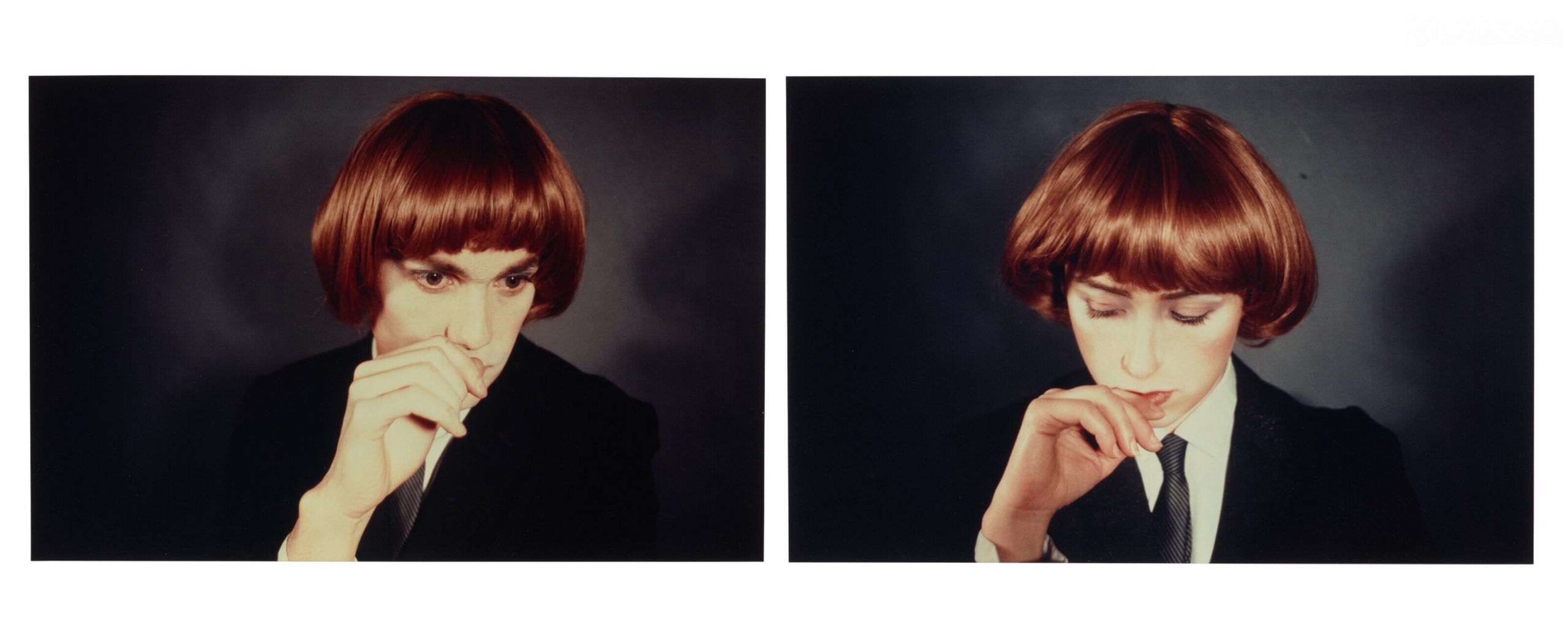
Richard Prince and Cindy Sherman. Double Self-Portrait, 1980
Richard Prince presented, or rather re-presented, his early new image work at the Gagosian Gallery. Everything was rendered as new in that almost all the works were radically reformatted and in turn made fresh to the market in what was a case of shining immediacy.
The question that looms over such a strategy of presenting old work in a new guise then is it in fact old or is it new. This is not just a semantic issue. The only work which was not based upon image appropriation or reconfiguration was a double portrait of himself coupled with a portrait of Cindy Sherman. It is difficult at first sight to work out who is who which of course is the point of the work, as there is no essential means of understanding such difference in the age of simulation. In many ways it starts to serve as a template for the proceeding career of Cindy Sherman with her disappearance into the visual identities of the other. Richard Prince himself became ever more elusive than this, with his spook like disappearance into authorship which always beg to the question of where and who is he?
理查德·普林斯(Richard Prince)在高古軒畫廊(Gagosian Gallery)展示,或者更準確地說,是「再展示」了他早期的新圖像作品(New Image)。幾乎所有作品都被徹底重新格式化,以嶄新的面貌呈現於市場,散發出一種光鮮亮麗的即時感。
然而,這種將舊作以新姿態呈現的策略引發了一個問題:這些作品究竟是舊的,還是新的?這並非單純的語義爭辯。展覽中唯一一件未基於圖像挪用或重構的作品是一幅雙人肖像畫,描繪了他自己和辛迪·舍曼(Cindy Sherman)。乍看之下,很難分辨誰是誰,這正是作品的核心意圖——在模擬時代,理解這種差異的本質性途徑已然瓦解。
在某種程度上,這幅作品為辛迪·舍曼的職業生涯提供了一個模板——象徵她逐漸消融於「他者」的視覺身份中。而理查德·普林斯則更加難以捉摸,他像幽靈般消失於作者身份之中,留下的永遠是未解之問:他在哪裡?他是誰?
Afterword
Lines extend and cross over, nothing remaining fixed as memory intersects with imagination.
Persistent and enduring the self portrait circulates around itself, sometimes taking a stance within the foreground, sometimes as background as if emerging out of the shadows cast by the self. No doubt the greatest body of work pertaining to the self-portrait is by Rembrandt who infused his study of his own appearance with a range of tonalities of lighting and shadow from which forces opened in heterogeneous directions within emotional flight. In many respects it was Rembrandt who opened out the serialisation of the face as a means of portraying the complexity of what endures within the encounter. This cross over of emotional intensity and visual coding and spacing implicated itself within the modern advent of cinema as much as in the art of painting and photography. The question that is posed within modernity was to what extent is the self-portrait responsible as a generative principle that implied that all works have their foundational impulse within it on the level of the gesture it contained. If we take Pollock’s retort of not painting nature, but ather being nature, it is possible to extend this sense into a reflex across the entire aesthetic template. So, what comes into focus with this, is the fold of subjectification and it is the operation of this fold that is central to what is at stake within late modernity. The relationship of photography to the self-portrait comes much more to the forefront because of its relationship to serialisation and the introduction of signs. In the photography of Lee Friedlander, Francesca Woodman, Robert Mapplethorpe, Cindy Sherman, and Nan Goldin there are inventive ways of constructing narratives pertaining to the employment of the self as sign. Clearly this signals a state of anxiety not just on the level of identity, gender, and sexuality but an uncertainty pertaining to authenticity within the culture. In this way the self-portrait becomes a potential sign of resistance but also retreat from a cultural that is saturated by signs of its disappearance.
後記
線條延伸交錯,記憶與想像彼此交融,無一事物得以保持固定。
自畫像以其不斷的旋轉與運行,或佇立於前景,或隱沒於背景,彷彿從自我投射的陰影中浮現。毫無疑問,自畫像最龐大的作品體系屬於倫勃朗(Rembrandt)。他將對自身外貌的研究注入了豐富而細膩的光影層次,這些層次開啟了多元情感的飛躍與延展。在某種程度上,正是倫勃朗開啟了面孔的系列化,將其作為描繪相遇複雜性的手段。這種情感強度與視覺編碼、空間佈局的交織,不僅深刻影響了繪畫與攝影,也對現代電影的誕生產生了重要啟發。
現代性提出的問題在於,自畫像作為一種生成原則,是否隱含了所有藝術作品的基礎性衝動——這一衝動體現在自畫像所包含的動作中。如果引用波洛克(Jackson Pollock)的回應「我不是在描繪自然,而是成為自然」,我們或許可以將這一觀點延伸至整個美學範疇。由此可見,主體化的「褶皺」成為現代性中至關重要的議題,而這種褶皺的運作正是晚期現代性的核心所在。
攝影與自畫像的關係,因其系列化與符號引入而愈發重要。在李·弗里德蘭德(Lee Friedlander)、弗朗西絲卡·伍德曼(Francesca Woodman)、羅伯特·梅普爾索普(Robert Mapplethorpe)、辛迪·舍曼(Cindy Sherman)與南·戈爾丁(Nan Goldin)的攝影作品中,我們可以看到他們以創新的方式構建敘事,將自我作為符號進行運用。這些作品無疑揭示了一種深層的不安——不僅關乎身份、性別與性向,還涉及文化中對真實性的模糊與懷疑。
因此,自畫像既是抵抗的潛在符號,又是從被符號化的文化中撤退的跡象——一種被自身消逝的符號所飽和的文化。
Text by Jonathan Miles

